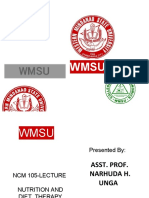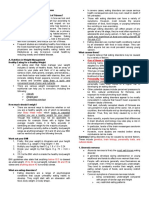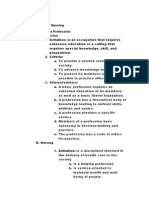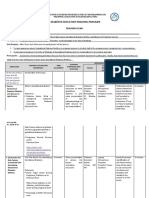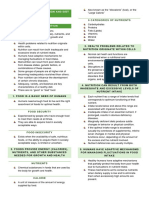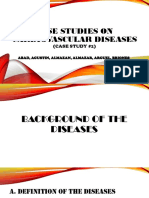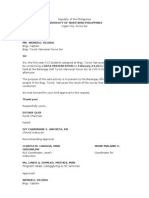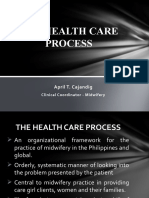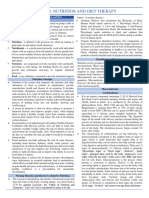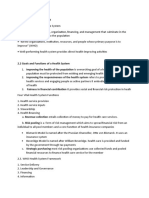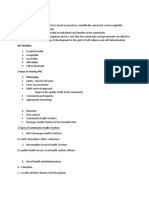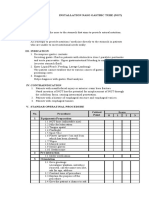Health Information System
(MLS 101) | BATCH 2024
College of allied medical professions – Lyceum of the Philippines university-batangas
CHAPTER III
Primary Health Care and the Philippine Health Care Delivery System
ALMA ATA DECLARATION OF 1978 This includes spectrum of services from prevention (i.e.
vaccinations and family planning) to management of chronic
According to this, health is a fundamental human right. health conditions and palliative care.
States that the most important global goal is for humans to
reach the optimal level of health. 5 KEY ELEMENTS TO ACHIEVE PHC’S GOAL
Adopted at
- International Conference on Primary Health Care Universal coverage to reduce exclusion and social
(PHC) disparities in health
- Almaty (formerly Alma-Ata), Kazakhstan Service delivery organized around people's need and
- September 6–12, 1978 expectations
- underlines the importance of primary healthcare. Public policy that integrates health into all sectors
Identifies primary health care as the key to the attainment Leadership that enhances collaborative models of
of the WHO's goal around the globe. policy dialogue
Increased stakeholder participation
World Health Organization’s Goal:
“Better Health for All"
ELEMENTS OF PRIMARY HEALTH CARE
GROSS INEQUALITY IN THE PEOPLE’S HEALTH
Education concerning prevailing health problems and the
methods of identifying, preventing and controlling them
- Prevailing concern of many countries including both Locally endemic disease prevention and control
developed and developing ones. Expanded program of immunization against major
infectious diseases
The government of each country has the duty and responsibility Maternal and child health care including family planning
to institute adequate measures to promote and protect its Essential drugs arrangement
people's health. Nutritional food supplement, an adequate supply of
safe, and basic nutrition.
DEFINITIONS Treatment of communicable and non-communicable
disease and promotion of mental health
HEALTH CARE SYSTEM Safe water and sanitation
“An organized plan of health service”
(Miller & Keane, 1987) OTHER ELEMENTS OF PRIMARY HEALTH CARE
HEALTH CARE DELIVERY Expanded options of immunization
“The rendering of health care services to people.”
Reproductive health needs
(Williams & Tungpalan, 1981)
Provision of essential technologies for health
HEALTH CARE DELIVERY SYSTEM Health promotion
“The network of health facilities and personnel which carries Prevention and control of non-communicable diseases
out the task of rendering health care to the people.” Food and safety and provision of selected food
(Williams & Tungpalan, 1981) supplements
PRIMARY HEALTH CARE PRINCIPLES OF PRIMARY HEALTH CARE
Important health care derived from scientifically sound and • Guides the functions of health systems as a whole
socially acceptable methods. It must be universally • Objectives to sustain PHC:
accessible to all individuals and is based on what the 1. Improve the level of health care of the community
community and country can provide (Alma-Ata 2. Promote favorable population growth structure
Declaration). 3. Reduce the morbidity and mortality rates especially
As an approach, it deals with social policy which targets among infants and children
health equity. 4. Reduce prevalence of preventable, communicable,
Ultimate goal: “Better health for all” and other diseases
5. Improve basic sanitation
Primary Health Care (WHO) 6. Extend essential health services especially to the
At its heart, primary health care is about caring for people, underserved sectors
rather than simply treating specific diseases or conditions. 7. Develop the capability of the community to become
self-reliant
8. Encourage the contribution of other sectors to the
PHC IS MADE UP OF 3 MAIN AREAS: social and economic development of the community
9. Provide equitable distribution of health care
Empowered people and communities 10. Ensure community participation and monitor
Multisectoral policy and action adequacy and distribution of health workers who are
Primary care and essential public health functions supported locally and at the referral levels
1
HEALTH INFORMATION SYSTEM | CHAPTER III-PRIMARY HEALTH CARE AND THE PHILIPPINE HEALTH CARE DELIVERY SYSTEM
� Health Information System
(MLS 101) | BATCH 2024
College of allied medical professions – Lyceum of the Philippines university-batangas
CHAPTER III
Primary Health Care and the Philippine Health Care Delivery System
11. Recognize that the formal health sector needs other
sectors in the promotion of health (multisectoral - identification of the key result areas (KRAs) per major activity
approach). - determination of the competencies and qualifications
12. Use the appropriate technology which are accessible, c. Recruit qualified personnel
feasible, affordable, and culturally acceptable to the d. Improve existing services and programs by:
community. - reviewing and adjusting the requirements accordingly
- matching the competency requirements vis-a-vis the
MANAGEMENT OF PRIMARY HEALTH CARE responsible personnel assigned to the activity
Health care managers carry out the following functions: THE PHILIPPINE HEALTH SYSTEM
1. Planning - setting priorities and determining performance • A complex set of organizations interacting to
targets provide an array of health services”.
2. Organizing - designing the organization or specific division, • In 1991, the LGUs took over the management of
unit, or service for which the manager is responsible health service delivery but the issue of fragmentation
3. Staffing - refers to acquiring and monitoring human has not been fully addressed.
resources, and developing and maintaining the workforce • Existing issues: underemployed workers, limited
4. Controlling - monitoring of staff activities and performance resources, unequal distribution
and taking the appropriate actions for corrective actions to
increase performance
5. Directing - focuses on initiating action in the organization THE DEPARTMENT OF HEALTH MANDATE
through effective leadership, motivation, and communication of
managers • E.O. No. 119, Sec. 3, the DOH has the responsibility
to create, plan, implement, and systematize national
MANAGEMENT PRINCIPLES health policies, advocacies, and programs.
• DOH's primary function is to promote, protect, and
1. Authority, Responsibility, and Accountability preserve or restore people's health by giving services
a. Authority - refers to the formal and legitimate right of and by monitoring and motivating health service
a manager to issue orders, make decisions, and providers.
allocate resources to achieve the desired outcomes • Also responsible for the issuance of health-related
b. Responsibility - duty of an employee to perform the licenses and accreditation and disseminating
assigned tasks and activities. information about national health indicators.
c. Accountability - reporting and justification of task
outcomes to higher management by those people VISION
with authority
• DOH vision by 2030 states:
2. Types of Authority
“A global leader for attaining better health outcomes,
a. Line Authority - managers issue orders to their
competitive and responsible health care system, and
subordinates and are also responsible for the results.
equitable health financing.”
b. Functional Authority - managers that have power
only over a specific set of activities.
c. Staff Authority - given to specialists in their areas of MISSION
expertise. The staff manager simply advises,
recommends, and counsels. • DOH mission states:
“To guarantee equitable, sustainable and quality health for
3. Centralization, Decentralization, and Formalization all Filipinos, especially the poor, and to lead the quest for
a. Centralization - refers to the concentration of excellence in health.”
planning and decision-making to the top of
organization. LEVELS OF HEALTH CARE FACILITIES
b. Decentralization - refers to the delegation of
planning and decision-making to the lower branches
of the organization. 1. Primary Level of Health Care Facilities
c. Formalization - refers to a written documentation • rural health units, their respective sub-centers, chest
provided for the direct control of the employee. clinics, malaria eradication units, and schistosomiasis
control units
4. Staffing • puericulture center operated by the League of
Puericulture Centers
With regards to staffing, the functions of the manager are: • units operated by the Philippine Tuberculosis Society
such as tuberculosis clinics and hospitals
a. assign individuals to respective positions identified in • clinics operated by the Philippine Medical Association
the management plan. • clinics operated by large industrial firms for their
b. assess required competencies through: employees
• Health centers and community hospitals operated by
the Philippine Medical Care Commission
2
HEALTH INFORMATION SYSTEM | CHAPTER III-PRIMARY HEALTH CARE AND THE PHILIPPINE HEALTH CARE DELIVERY SYSTEM
� Health Information System
(MLS 101) | BATCH 2024
College of allied medical professions – Lyceum of the Philippines university-batangas
CHAPTER III
Primary Health Care and the Philippine Health Care Delivery System
• other health facilities operated by voluntary religious
and civic groups.
2. Secondary Level of Health Care Facilities
• includes the smaller and non-departmentalized
hospitals
3. Tertiary Level of Health Care Facilities
• specialized national hospitals which offer highly
technological and sophisticated services.
LEVELS OF PRIMARY HEALTH CARE WORKERS
1. Grassroot or Village Health Workers
initial links of the community to health care
provide preventive health care measures and simple
curatives to promote a healthy environment
encourage programs/activities such as food
production programs to improve the socio-economic
level of the community
volunteers, community health workers, or traditional
birth attendants
2. Intermediate Level Workers
• first source of professional health care
• attend to health problems which are already beyond
the competencies of village workers
• provide supervision, training, supplies, and services
that provide support to front-line health workers
• medical practitioners, nurses, and midwives
3. First-line Hospital Personnel
• serve as the backup health service providers, in case
of hospitalizations
• in close contact with intermediate level health workers
or village health workers
• physicians with specialty, nurses, dentists,
pharmacists, and other health professionals
The categories of health workers are affected by certain factors
such as:
.the availability of health manpower resources
the presence of health care concerns and needs of
the locality, and
the issue of financial and political feasibility.
Prepared by:
Dimayuga, Justin
Salvacion, Alessio Von
Villanueva, Sophia
https://tinyurl.com/TransMLS1B
3
HEALTH INFORMATION SYSTEM | CHAPTER III-PRIMARY HEALTH CARE AND THE PHILIPPINE HEALTH CARE DELIVERY SYSTEM

